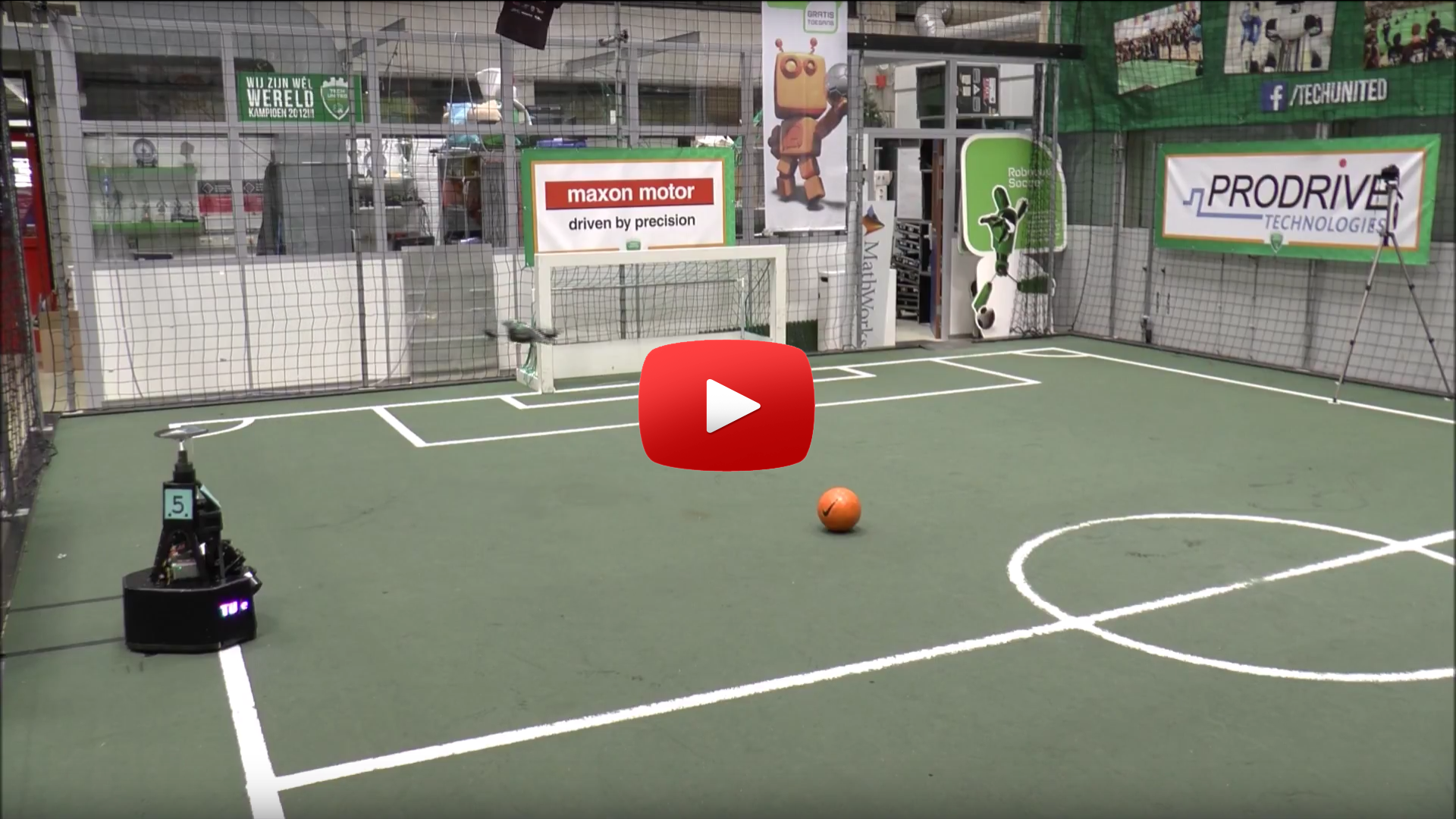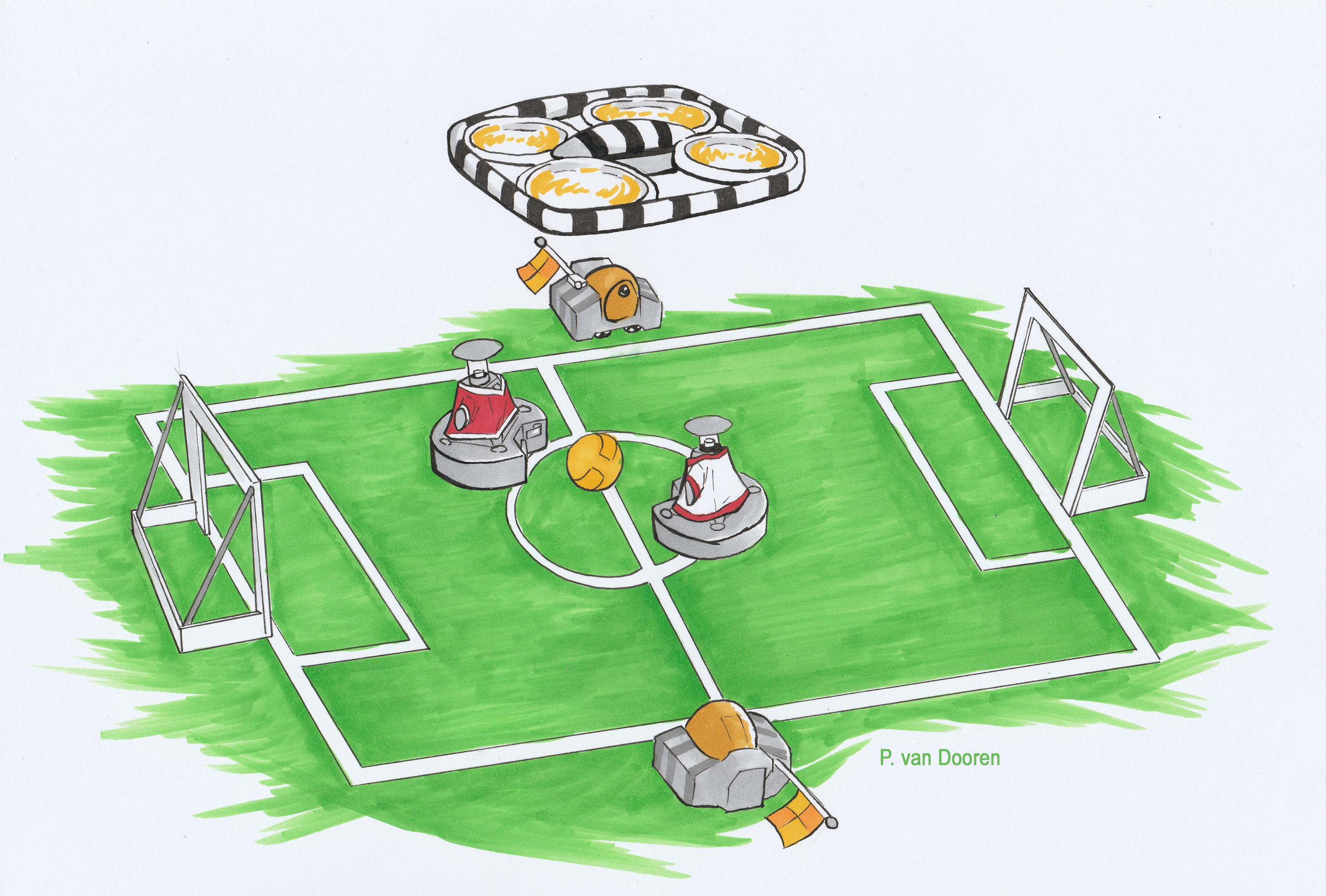AutoRef - Autonomous Referee System: Difference between revisions
20204923@TUE (talk | contribs) |
20204923@TUE (talk | contribs) |
||
| Line 45: | Line 45: | ||
The history of [[#Team contributions|team contributions]] to AutoRef's development is marked by a shift in paradigm starting with MSD 2020 which emphasizes project continuity and removes the specification of quadcopter drones as a basis for the autonomous refereeing system. In other words, its history can be defined as two paradigms: | The history of [[#Team contributions|team contributions]] to AutoRef's development is marked by a shift in paradigm starting with MSD 2020 which emphasizes project continuity and removes the specification of quadcopter drones as a basis for the autonomous refereeing system. In other words, its history can be defined as two paradigms: | ||
#the [[#2015–2020 (drone-based system)|2015–2020 system]] based on various quadcopter | #the [[#2015–2020 (drone-based system)|2015–2020 system]] based on various quadcopter drones; and | ||
#the [[#2021–present|2021–present system]]. | #the [[#2021–present|2021–present system]]. | ||
Revision as of 18:06, 30 March 2021
Note: This page is being actively modified.
The AutoRef system is a proposed autonomous referee for RoboCop Middle Size League (MSL) robot soccer under development at Eindhoven University of Technology (TU/e). It is intended to accomplish all refereeing duties of human referees in MSL. Development of the AutoRef system architecture and implementation began in 2016 by TU/e PDEng trainees in the 2015–2017 cohort of the Mechatronic Systems Design (MSD) program as their Block II in-house project. Since then, each MSD cohort has contributed to AutoRef's continuation in their respective Block II in-house projects. In TU/e's 2019–2020 academic year, a team of students in the Honors program High Tech Systems realized the control of drones as part of AutoRef's implementation, with continued efforts in drone control by these students leading to the Firefly-project.
AutoRef experienced multiple iterations of its project definition from its inception in 2016 through 2020, consequently leading to poor overall project progress across different teams. Earlier MSD cohorts emphasized a fully autonomous referee, while later years scoped the project towards an assistive, supplementary system for human referees. In 2021, to prevent further repetitive efforts in the design of AutoRef, the 2020–2022 MSD cohort project team (AutoRef PDEng MSD 2020 or simply MSD 2020) was specifically tasked with ensuring continuity for future work.
Beginning with MSD 2020's work, the AutoRef's system architecture and implementation pages describe the current state of the project "as-is" without the voice or perspective of any specific team's contribution. The seperate pages of previous teams (i.e., MSD 2015–2019 and Honors 2019) describe their own respective contributions, with an archive provided by MSD 2020 which systematically describes these team contributions https://teams.microsoft.com/l/file/EA8BF37F-3469-4424-9010-BEADD8E96EE9?tenantId=cc7df247-60ce-4a0f-9d75-704cf60efc64&fileType=xlsx&objectUrl=https%3A%2F%2Ftuenl.sharepoint.com%2Fsites%2FMCS_Drone_Referee_project_Team%2FShared%20Documents%2FGeneral%2FAutoRef%20Project%202020%20Final%20Deliverables%2FDocumentation%20%26%20Archive%2FArchive%20of%20past%20year's%20work.xlsx&baseUrl=https%3A%2F%2Ftuenl.sharepoint.com%2Fsites%2FMCS_Drone_Referee_project_Team&serviceName=teams&threadId=19:67b92555afdd4fdbbc40f984fb35696c@thread.tacv2&groupId=1efe2c69-ea31-43f1-9b96-c1c8cfa600e6.
Background
- This section's tone or style may not reflect the encyclopedic tone as used in articles such as those on Wikipedia. See Wikipedia's guide to writing better articles for suggestions.
RoboCup
RoboCup is an international initiative to promote and advance research in robotics and artificial intelligence. Founded in 1997, its main goal is to ‘develop a team of fully autonomous humanoid robot soccer players that is able to win against the winner of the most recent World Cup, complying with the official rules of FIFA, by the middle of the 21st century’.
Middle Size League (MSL)
In RoboCup's Middle Size League (MSL), two teams of five autonomous robots play a soccer match on an artificial field. These robots are able to drive around while using several on-board camera's to position themselves on the field. Moreover, they can determine the position of the ball, opponents and team mates. Through radio signals they can communicate with each other and decide upon a strategy. With a ball-handling system the ball can be captured and controlled and a shooting mechanism is able to shoot a ball over the ground or through the air.
As discussed in this tutorial, a standard RoboCup field measures 18 by 12 meters. During a match, there are two teams consisting of five robots on this field, driving around with velocities up to 5 m/s and possibly even higher. These robots are all competing for the same thing: scoring goals. This means that getting possession of the ball is a primary goal. When several robots are competing for the ball, collisions, pushing and scrummages are nearly inevitable.
Human refereeing
To ensure each MSL match is played fairly, a human referee observes events on the field from the sideline. This human referee is supported by an auxiliary referee who stands on the opposite side, next to the field. Both referees can stop the game in response to a committed foul, a scored goal, a ball out of bounds, and other game events as specified in the MSL rules. The MSL rules are based on the official FIFA rules, but adapted to robot soccer rules were necessary. However, the large set of rules and the interpretation thereof can often lead to situations where a referee might decide to continue the game, while another might decide to interrupt. This can and will often lead to frustrations in the aggrieved team. Moreover, a decision made by a referee can affect the outcome of a game and even an entire championship.
RoboCup 2016 Leipzig: MSL final match
The outcome-affecting nature of refereeing was evident in the final match of the RoboCup world championship 2016 in Leipzig, Germany (full match; match highlights). The final was played between team TechUnited from the Netherlands and team WATER from China. The winner of this would become world champion robot soccer in the MSL. At the end of the match, the scoreboard showed 2-2. Per MSL rules (as is in FIFA rules), a tied score results in extra time to decide on the winner. During the match, team WATER faced issues with ball handling, preventing the ball from rotating in a ‘natural’ way over the field. When it happens that the ball does not rotate in the direction it is being moved, this is considered clamping and regarded as a foul in favor of the other team. In the last couple of minutes the score was 3-3 when WATER turned towards the TechUnited goal, shot and scored the winning goal. While the Chinese team was already celebrating their victory, the auxiliary referee decided that the scoring robot was clamping the ball before scoring the goal. After a discussion with the main referee, it was decided to declare the goal invalid. Since the extra time also ended in a draw, penalties were needed to decide who would become the new world champion. After all penalties of the Chinese team were stopped by the Dutch keeper, the first shot of the TechUnited robot went into the net. The Dutch team won the penalty series with 1-0 and thus TechUnited became the world champion of 2016.

AutoRef motivation
The events of the 2016 final match between the Dutch and Chinese MSL teams show how the decisions of human referees can affect the outcome of a match or even a tournament. Rules are always prone to interpretation, and a team which is disadvantaged by this will always complain. Referees have little means to justify their decisions other than their own observations and interpretations of the rules.
Referees in human soccer already use technology to support their decisions. Nowadays, several stadiums are already equipped with goal line technology and referees can be assisted by a Video Assistant Referee (VAR). If the use of technology keeps increasing, a human referee for might one day become entirely obsolete. The proceedings of a match could be measured and evaluated by some system of sensors. With enough (correct) data, this system would be able to recognize certain events and make decisions based on these event.
Robot soccer in RoboCup MSL can likewise benefit from such an autonomous refereeing system — an AutoRef — to ensure matches are played fairly.
Development history
Note: This chapter is being actively modified.
Development of the AutoRef system architecture and implementation began in 2016 by TU/e PDEng trainees in the 2015–2017 cohort of the Mechatronic Systems Design (MSD) program as their Block II in-house project. Since then, each MSD cohort has contributed to AutoRef's continuation in their respective Block II in-house projects. In TU/e's 2019–2020 academic year, a team of students in the Honors program High Tech Systems realized the control of drones as part of AutoRef's implementation, with continued efforts in drone control by these students leading to the Firefly-project.
The history of team contributions to AutoRef's development is marked by a shift in paradigm starting with MSD 2020 which emphasizes project continuity and removes the specification of quadcopter drones as a basis for the autonomous refereeing system. In other words, its history can be defined as two paradigms:
- the 2015–2020 system based on various quadcopter drones; and
- the 2021–present system.
2016–2020 (drone-based system)
AutoRef's 2016–2020 development phase in 2016 based on camera-equipped quadcopter drones to help monitor RoboCop Middle Size League (MSL) robot soccer matches.
Most of the projects from 2016 systems engineering approach should be taken during the design.
The MSD 2015–2019 and Honors 2019 projects described are often of short duration. Moreover, every year the projects are done with new teams, which have their own ideas and approaches. These teams create their own documentation to show what they have done, such that they can be graded. Sometimes they use previous work as inspiration, but often they start from scratch with their own ideas. While this can give new perspectives on the system, it slows down the progress of creation. Instead of going progressing through the entire V-Model with each new group, we keep repeating the Project Definition (left side of the V).
AutoRef experienced multiple iterations of its project definition from its inception in 2016 through 2020, consequently leading to poor overall project progress across different teams. Earlier MSD cohorts emphasized a fully autonomous referee, while later years scoped the project towards an assistive, supplementary system for human referees. In 2021, to prevent further repetitive efforts in the design of AutoRef, the 2020–2022 MSD cohort project team (AutoRef PDEng MSD 2020 or simply MSD 2020) was specifically tasked with ensuring continuity for future work.

2021–present
The current phase of AutoRef is marked most notably by its basis that is not drone-based. Specifically Starting with MSD 2020, the current
Emphasizing the original AutoRef intention to accomplish all refereeing duties of human referees in MSL through an autonomous system.
Beginning with MSD 2020's work, the AutoRef's system architecture and implementation pages describe the current state of the project "as-is" without the voice or perspective of any specific team's contribution. Team contributions are described on their respective pages: pages for pre-MSD 2020 projects provide standalone descriptions of their respective architecture and implemention; pages for MSD 2020 onwards decribe their contribution, with detailed documentation kept on the AutoRef's pages. An archive provides a condensed overview with respect to all team contributions https://teams.microsoft.com/l/file/EA8BF37F-3469-4424-9010-BEADD8E96EE9?tenantId=cc7df247-60ce-4a0f-9d75-704cf60efc64&fileType=xlsx&objectUrl=https%3A%2F%2Ftuenl.sharepoint.com%2Fsites%2FMCS_Drone_Referee_project_Team%2FShared%20Documents%2FGeneral%2FAutoRef%20Project%202020%20Final%20Deliverables%2FDocumentation%20%26%20Archive%2FArchive%20of%20past%20year's%20work.xlsx&baseUrl=https%3A%2F%2Ftuenl.sharepoint.com%2Fsites%2FMCS_Drone_Referee_project_Team&serviceName=teams&threadId=19:67b92555afdd4fdbbc40f984fb35696c@thread.tacv2&groupId=1efe2c69-ea31-43f1-9b96-c1c8cfa600e6.
System architecture
Note: This chapter is being actively modified.
- Main article: AutoRef system architecture
Implementation
Note: This chapter is being actively modified.
- Main article: AutoRef implementation
Team contributions
Note: This chapter is being actively modified.
Prior to MSD 2020, AutoRef's documentation was decentralized across individual team pages. The continuous project nature of AutoRef across
This page is the centralization of AutoRef, created to centralize the contributions of teams.
All decisions, requirements, functionalities etc. will be explained here. This approach can lead to difficulties in grading the students/teams, since it might not be clear what part exactly they have contributed to. Therefore a separate page is made for each team. Contributions to the system (see navigation box).
Team-specific pages (such as this one) are for explaining a team's contribution to the overall AutoRef project. Team-specific pages from MSD 2020 onwards do not provide detailed descriptions of the AutoRef system.
PDEng
- MSD 2015 (cohort 2015–2017)
- MSD 2016 (cohort 2016–2018)
- MSD 2017 (cohort 2017–2019)
- MSD 2018 (cohort 2018–2020)
- MSD 2019 (cohort 2019–2021)
- MSD 2020 (cohort 2020–2022)